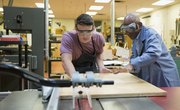Although it's much easier to get into a trade school than a selective four-year college, that doesn’t mean vocational courses are for students who aren’t college material. Students of all ability levels can find exciting trade school programs that pique their interest. Trade schools offer practical training to prepare students for steady jobs in industry, manufacturing, construction, information technology, business, health care and so much more. Smart students weigh all their options before choosing a career path.
Tip
Most trade schools require a high school diploma or a GED for admission. Programs like nursing with a strong academic component have additional requirements, such as above average scores on college placement tests.
What’s Trade School?
Trade school is a type of vocational school, meaning that the curriculum has a narrow focus that readies students for a specific career field. Course instruction may include reading textbooks and written exams, but emphasis is placed on hands on learning. Traditionally, trade schools taught mechanical skills like plumbing, auto repair and carpentry. Today, options are far more diverse, offering something for everyone.
New vocational training programs are springing up all the time to meet changing workforce needs. Industries compete with each other to attract recent graduates that are up to speed on the latest technology. Jobs are continually being created and phased out as machines and robots replace untrained manual laborers.
What’s Trade School Like?
Students enjoy trade school because they are able to concentrate on subjects they enjoy. Instead of sitting in little desks all day, vocational students learn in labs, studios, automotive garages, airport hangars, salons, retail and other work sites. Liberal arts are generally not a big part of the curriculum. Your day will be spent learning and practicing the actual skills used in your occupation.
Paying attention is important if you want to succeed in your job and establish a solid reputation. In addition, many of the trades require a passing score on a state or local licensing exam, which helps protect the public from malpractice. For instance, cosmetologists, nurses, master electricians and plumbing contractors must complete training and obtain a license before they can offer their services for hire.
Some trade schools also offer student clubs, guest speakers and social events. Because classes are small, it is easy to make friends and get to know your teachers. The cafeteria may offer delicious fresh baked goods if the school has a culinary arts program. Parking at many trades schools is less of a hassle than at a large university that charges high prices to park in a remote lot requiring a shuttle ride to campus.
Trade School Definition
The trade school definition includes various types of educational instruction available at for-profit trade schools, public vocational institutions and community colleges with vocational tracks. Trade school is generally offered at the post-secondary level but some high schools partner with a trade school to offer vocational classes for students as young as 14. Trade schools help keep the economy humming by producing workers with the cutting-edge skills essential to modern manufacturing.
Occupations categorized as a “trade” require skill, dedication and practice. Tradespeople in society provide a valuable service or product. Advancement opportunities are available to those who are ambitious and excel in their trade. For instance, cosmetologists, electricians and plumbers may become managers, business owners and trade school teachers.
Advantages of Trade School
The trades are booming, and the demand for workers with technical skills has skyrocketed. What’s more, you can launch a career in the trades and start making good money sooner than your college-bound peers. Better yet, you will not graduate with few job prospects or crippling student loan debt, assuming you attend one of many affordable trade schools with high placement rates.
If you like working with your hands and need useful skills to escape a dead-end job, you may want to consider enrolling in a trade school where you will master your craft in realistic work settings. Trade schools also offer flexible schedules: daytime and evening vocational courses along with online classes. In two years or less, you can acquire technical skills that are in hot demand.
Students can enter the workforce or earn a promotion after earning a certificate in a few short weeks. Diplomas take several months. An associate degree generally involves two years of study.
Trade School Requirements for Admission
Admittance to a technical or vocational school usually requires a high school diploma, GED or state approved home schooling. At a minimum, you must submit an admissions application along with high school transcripts or GED certificate and pay a small, non-refundable processing fee. Some trade schools also encourage or require a campus visit to meet faculty and tour the facilities. Previous training in the military or completion of an apprenticeship can be helpful if the program sets enrollment caps.
You will likely take the Accuplacer or similar college placement test that assesses readiness for college. Exceptions are made in some situations, such as previous college coursework or strong ACT scores. Programs with limited enrollment may have additional prerequisites. For instance, trade school requirements for admission to a medical assistant or veterinary technician program may require above average Accuplacer scores in reading and math.
Bypassing Trade School Admission Requirements
Don’t give up hope of achieving your dream job if you don’t meet standard trade school requirements for admission. Trade schools strive to make education readily available to all who can benefit. According to the U.S. Department of Education, federal laws were changed in 2014 to allow qualified individuals without a diploma or GED to enroll and receive financial aid at schools that offer an alternative career pathway program.
To qualify for a career pathways program, students without a high school diploma or equivalency must demonstrate that they have the capacity to benefit from post secondary instruction. Applicants have the option of passing a federally approved basic skills test, or they can prove themselves college ready by taking and paying for six credits (225 clock hours). Once enrolled, students are eligible for ongoing support services, counseling and tutoring to help them shore up rusty skills.
For those who didn’t finish high school, there are also trade schools that help students prepare to take the GED. Students can receive instruction in basic math, reading, writing and English at a trade school, community college or adult basic education program. Lack of education doesn’t have to be a barrier to career training and a better life.
Trade School vs. College
One of the most important decisions you will make in life is where to further your education. Trade school is not for you if you have no idea what you want to study. Undecided students may find it helpful to take general education classes at a community college to learn more about possible career areas.
Trade school classes are typically small and directly related to your intended career interests. A vocational curriculum is very structured, so you don’t have to fret over what classes to take each term. Your earning potential will vary significantly depending on the career or major you pursue.
Trade schools and colleges both offer wonderful opportunities that open doors to attractive careers. Some students enter trade school to gain work experience while saving money for college. For example, you might want to complete Emergency Medical Technician training, work as a first responder for a while and later pursue a nursing degree.
Trade School Career Possibilities
When selecting a career, consider what jobs match your interests, personality, abilities, values and salary needs. Identify the factors that matter most to you in a job. Determine the type of environment that best suits you. Many career programs can be found at trade schools across the country that lead to challenging and rewarding jobs in a related field of study.
Examples of popular jobs:
- Accountant
- Chef
- Childcare worker
- Dental assistant
- Esthetician
- Graphic designer
- Interior designer
- Law enforcement officer
- Nurse
- Paralegal assistant
- Transportation manager
Examples of unique jobs:
- Brewery master
- Cybersecurity technician
- Forensic technician
- Funeral services specialist
- Gunsmith
- Maritime technologist
- Viticulturist
You can find trade school jobs that pay very well, especially in STEM fields, including green technology. Some types of skilled jobs didn’t exist until recently, and the need for trained workers is acute. For instance, demand for solar panel installers is projected to grow 105 percent between 2016 and 2026, according to the Bureau of Labor Statistics.
Salaries can be well above the median annual income of $37,690 earned by all workers, as reported by BLS in May 2017. Median means that half of all workers in that occupation earned less, and half earned more. Salaries are highest in occupations where the demand exceeds availability.
Examples of median salaries:
- Air traffic controller: $124,540
- Aviation mechanic: $61,260
- Electrician: $54,110
- Radiographer: $60,070
- Web Developers: $67,990
- Wind turbine technician: $53,880
What’s the Cost of Trade School?
Shop around and compare the many types of trade schools that offer practical training. Cost varies substantially. Look for accredited schools that offer federal and state financial aid to those who submit the Free Application for Federal Student Aid and qualify for need based assistance.
Public trade schools typically cost far less than four-year colleges and for-profit trade schools. Along with paying tuition and student fees, you may need to buy books, tools, supplies and uniforms. Reputable schools will be transparent in disclosing costs. For example, Pine City Technical and Community College clearly indicates on their website that in 2019 students completing a one-year welding technology certificate pay a total of $5,082 in tuition and fees along with $2,000 for supplies.
Before committing to any program, make sure the school is fully accredited and respected by industry leaders. Investigate the percentage of students who finish the program and quickly land jobs in a closely related field. Ask about internship opportunities. A top-notch costly school with a high job placement rate may be a better bet in the long run than an inexpensive school with a low job placement rate.
High School Preparation
High school is an ideal time to start exploring careers and gaining skills that will make you employable. Many students who enroll in trade school already have some experience in the trades, which is what led them to a vocational career. Look for paid or volunteer opportunities that can introduce you to the world of work. No matter what career you desire, classes in English, math and communication can be beneficial.
Also, talk to your guidance counselor about your career interests. Inquire about vocational courses, apprenticeships and job training programs offered through your school. Some high schools have strong career and technical education programs like mechanical drafting, information technology, dental assisting and automotive repair. You may be required to interview with school staff before you can sign up for vocational education. Other high schools have open admission policies.
Some trade schools offer associate degrees that can lead to an entry-level job or credits may transfer to a four-year college. High school classes provide a solid foundation for post-secondary study. For instance, if you are interested in an associate degree in forensic technology to help process crime scenes, you could benefit from high school classes in chemistry, pathology, digital media, sketching and abnormal psychology.
Related Articles
References
- Dakota County Technical College: Admissions Checklist
- Bureau of Labor Statistics: Solar Photovoltaic Installers
- Bureau of Labor Statistics: Highest Paying Occupations that Typically Require Less than a Bachelor's Degree for Entry, May 2017
- Bureau of Labor Statistics: Air Traffic Controllers
- Bureau of Labor Statistics: Radiologic and MRI Technologists
- Pine Technical and Community College: Undergraduate Certificate in Welding Technology
Writer Bio
Dr. Mary Dowd is a dean of students whose job includes student conduct, leading the behavioral consultation team, crisis response, retention and the working with the veterans resource center. She enjoys helping parents and students solve problems through advising, teaching and writing online articles that appear on many sites. Dr. Dowd also contributes to scholarly books and journal articles.











